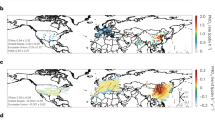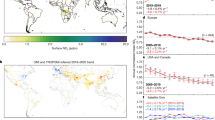Abstract
Ozone (O3) has harmful effects on human health and ecosystems. In the USA, significant reductions of O3 precursors—nitrogen oxides (NOx) and volatile organic compounds (VOCs)—have not yielded proportionate decreases in O3. NOx is a major precursor of O3 as well as a quencher of O3 through NOx titration, which is especially important during the night and wintertime. In this study, we investigated the potential dual impact of NOx concentration decreases on recent O3 trends by season and time of day. We analyzed hourly O3 and NOx measurement data between 1994 and 2010 in the continental USA. Nationally, hourly O3 concentrations decreased by as much as −0.38 ppb/year with a standard error of 0.05 ppb/year during the warm season midday, but increased by as much as +0.30 ± 0.04 ppb/year during the cold season. High O3 concentrations (≥75th percentile) during the warm season decreased significantly, however, there were notable increases in the cold season as well as warm season nighttime; we found that these increases were largely attributable to NOx decreases as less O3 is quenched. These O3 increases, or “penalties”, related to NOx reductions remained robust at a wide range of O3 concentrations (5th to 99th percentile), and even after accounting for VOC reductions and meteorological parameters, including temperature, wind speed, and water vapor pressure. In addition, we observed O3 penalties across rural, suburban, and urban areas. Nonetheless, peak O3 concentrations (99.9th percentile) were mitigated by NOx reductions. In addition, there was some suggestive evidence that VOC reductions have been more effective in reducing O3.








Similar content being viewed by others
References
Barmpadimos I, Keller J, Oderbolz D, Hueglin C, Prévôt ASH (2012) One decade of parallel fine (PM2.5) and coarse (PM10–PM2.5) particulate matter measurements in Europe: trends and variability. Atmos Chem Phys 12:3189–3203
Bell ML, Hobbs BF, Ellis H (2005) Metrics matter: conflicting air quality rankings from different indices of air pollution. J Air Waste Manag Assoc 55:97–106
Berkey C, Hoaglin D, Antezak-Bouckoms A, Mosteller F, Colditz G (1998) Meta-analysis of multiple outcomes by regression with random effects. Stat Med 17:2537–2550
Blanchard CL, Hidy GM, Tanenbaum S (2010a) NMOC, ozone, and organic aerosol in the southeastern United States, 1999–2007: 2. Ozone trends and sensitivity to NMOC emissions in Atlanta, Georgia. Atmos Environ 44:4840–4849
Blanchard CL, Hidy GM, Tanenbaum S, Rasmussen R, Watkins R, Edgerton E (2010b) NMOC, ozone, and organic aerosol in the southeastern United States, 1999–2007: 1. Spatial and temporal variations of NMOC concentrations and composition in Atlanta, Georgia. Atmos Environ 44:4827–4839
Bloomer BJ, Vinnikov KY, Dickerson RR (2010) Changes in seasonal and diurnal cycles of ozone and temperature in the eastern U.S. Atmos Environ 44:2543–2551
Burnett RT, Stieb D, Brook JR, Cakmak S, Dales R, Raizenne M et al (2004) Associations between short-term changes in nitrogen dioxide and mortality in Canadian cities. Arch Environ Health 59:228–236
Butler TJ, Vermeylen FM, Rury M, Likens GE, Lee B, Bowker GE et al (2011) Response of ozone and nitrate to stationary source NOx emission reductions in the eastern USA. Atmos Environ 45:1084–1094
Chameides W, Fehsenfeld F, Rodgers MO, Cardelino C, Martinez J, Parrish D et al (1992) Ozone precursor relationships in the ambient atmosphere. J Geophys Res 97:6037–6055
Cooper OR, Gao R-S, Tarasick D, Leblanc T, Sweeney C (2012) Long-term ozone trends at rural ozone monitoring sites across the United States, 1990–2010. J Geophys Res 117, D22307
Fiore AM, Jacob D, Bey I, Yantosca R, Field B, Fusco A (2002) Background ozone over the United States in summer: origin, trend, and contribution to pollution episodes. J Geophys Res 107:4275
Fiore A, Jacob DJ, Liu H, Yantosca RM, Fairlie TD, Li Q (2003) Variability in surface ozone background over the United States: implications for air quality policy. J Geophys Res 108:4787
Fitzmaurice G, Laird N, Ware J (2011) Applied longitudinal analysis, 2nd edn. John Wiley & Sons, New York
Gégo E, Porter PS, Gilliland A, Rao ST (2007) Observation-based assessment of the impact of nitrogen oxides emissions reductions on ozone air quality over the eastern United States. J Appl Meteorol 46:994–1008
Hastie T, Tibshirani R (1990) Generalized additive models. Chapman & Hall, New York
Jaffe D, Ray J (2007) Increase in surface ozone at rural sites in the western US. Atmos Environ 41:5452–5463
Jhun I, Oyola P, Moreno F, Castillo MA, Koutrakis P (2013) PM2.5 mass and species trends in Santiago, Chile, 1998 to 2010: the impact of fuel-related interventions and fuel sales. J Air Waste Manag Assoc 63:161–169
Koenker R, Bassett G Jr (1978) Regression quantiles. Econometrica 46:33–50
Langford A, Brioude J, Cooper O, Senff C, Alvarez R, Hardesty R et al (2012) Stratospheric influence on surface ozone in the Los Angeles area during late spring and early summer of 2010. J Geophys Res 117:D00V06
Lefohn A, Oltmans S, Dann T, Singh H (2001) Present-day variability of background ozone in the lower troposphere. J Geophys Res 106:9945–9958
Lefohn AS, Shadwick D, Oltmans SJ (2010) Characterizing changes in surface ozone levels in metropolitan and rural areas in the United States for 1980–2008 and 1994-2008. Atmos Environ 44:5199–5210
Lefohn AS, Wernli H, Shadwick D, Limbach S, Oltmans SJ, Shapiro M (2011) The importance of stratospheric-tropospheric transport in affecting surface ozone concentrations in the western and northern tier of the United States. Atmos Environ 45:4845–4857
Lefohn AS, Wernli H, Shadwick D, Oltmans SJ, Shapiro M (2012) Quantifying the importance of stratospheric-tropospheric transport on surface ozone concentrations at high- and low-elevation monitoring sites in the United States. Atmos Environ 62:646–656
Lefohn AS, Emery C, Shadwick D, Wernli H, Jung J, Oltmans SJ (2014) Estimates of background surface ozone concentrations in the United States based on model-derived source apportionment. Atmos Environ 84:275–288
Lin M, Fiore AM, Cooper OR, Horowitz LW, Langford AO, Levy H et al (2012) Springtime high surface ozone events over the western United States: quantifying the role of stratospheric intrusions. J Geophys Res 117:D00V22
Parrish D, Ryerson T, Holloway J, Trainer M, Fehsenfeld F (1999) New directions: does pollution increase or decrease tropospheric ozone in winter-spring? Atmos Environ 33:5147–5149
Politis D (2003) The impact of bootstrap methods on time series analysis. Stat Sci 18:219–230
Reynolds SD, Blanchard CL, Ziman SD (2003) Understanding the effectiveness of precursor reductions in lowering 8-hr ozone concentrations. J Air Waste Manag Assoc 53:2543–2551
Samet JM, Zeger SL, Dominici F, Curriero F, Coursac I, Dockery DW (2000) The national morbidity, mortality, and air pollution study, part II : morbidity and mortality from air pollution in the United States. Health Effects Institute, Boston
Samoli E, Aga E, Touloumi G, Nisiotis K, Forsberg B, Lefranc A et al (2006) Short-term effects of nitrogen dioxide on mortality: an analysis within the APHEA project. Eur Respir J 27:1129–1138
Sillman S (1999) The relation between ozone, NOx and hydrocarbons in urban and polluted rural environments. Atmos Environ 33:1821–1845
The National Academies Press (1991) Rethinking the ozone problem in urban and regional air pollution. Washington, DC
UNEP and WMO (2011) Integrated assessment of black carbon and tropospheric ozone summary for decision makers. Nairobi
US EPA (2009a) Assessment of theimpacts of global change on regional U.S. air quality: a synthesis of climate change impacts on ground-level ozone. Washington, DC
US EPA (2009b) Report on the environment volatile organic compounds emissions 2009. Washington, DC
US EPA (2009c) The NOx budget tradingprogram: 2008 environmental results. Washington, DC
US EPA (2010) Our nation’s air: status and trends through 2008. Research Triangle Park, NC
US EPA (2012) Our nation’s air: status and trends through 2010. Research Triangle Park, NC
Wang H, Jacob DJ, Le Sager P, Streets DG, Park RJ, Gilliland AB et al (2009) Surface ozone background in the United States: Canadian and Mexican pollution influences. Atmos Environ 43:1310–1319
WHO (2006) WHO air quality guidelines for particulate matter, ozone, nitrogen dioxide and sulfur dioxide. Geneva
Wilson RC, Fleming ZL, Monks PS, Clain G, Henne S, Konovalov IB et al (2012) Have primary emission reduction measures reduced ozone across Europe? An analysis of European rural background ozone trends 1996–2005. Atmos Chem Phys 12:437–454
Zheng J, Swall JL, Cox WM, Davis JM (2007) Interannual variation in meteorologically adjusted ozone levels in the eastern United States: a comparison of two approaches. Atmos Environ 41:705–716
Acknowledgments
This work was made possible by the Harvard School of Public Health Scholarship and the US EPA grant RD-834798-01. Its contents are solely the responsibility of the grantee and do not necessarily represent the official views of the US EPA. Further, the US EPA does not endorse the purchase of any commercial products or services mentioned in the publication. We thank Choong-Min Kang for his assistance with creating the dataset, Marianthi Kioumourtzoglou for her help with the bootstrap method development, and Elena Austin for her help with the quantile regression method. We also thank Joel Schwartz for his input on statistical analyses.
Author information
Authors and Affiliations
Corresponding author
Rights and permissions
About this article
Cite this article
Jhun, I., Coull, B.A., Zanobetti, A. et al. The impact of nitrogen oxides concentration decreases on ozone trends in the USA. Air Qual Atmos Health 8, 283–292 (2015). https://doi.org/10.1007/s11869-014-0279-2
Received:
Accepted:
Published:
Issue Date:
DOI: https://doi.org/10.1007/s11869-014-0279-2




